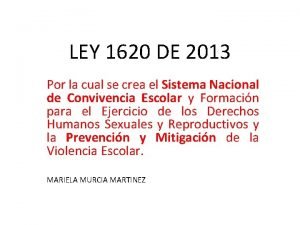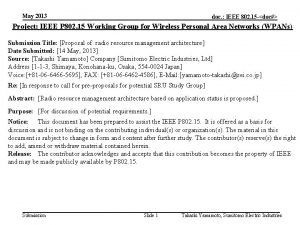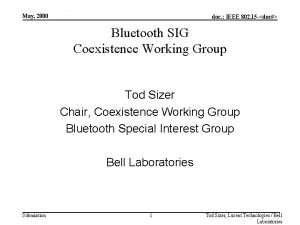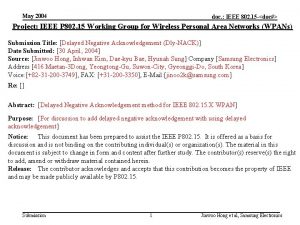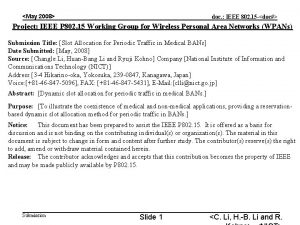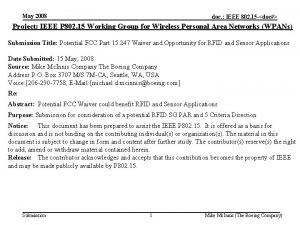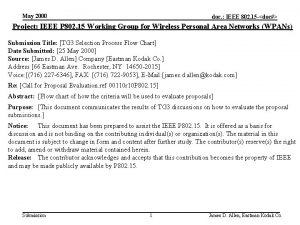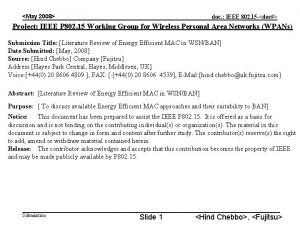May 2013 Doc IEEE 802 11 130517 r









![May 2013 Doc. : IEEE 802. 11 -13/0517 r 0 References [1] IEEE Std May 2013 Doc. : IEEE 802. 11 -13/0517 r 0 References [1] IEEE Std](https://slidetodoc.com/presentation_image_h2/859541e37d03df946c76ba10cc3213b9/image-10.jpg)

- Slides: 11

May 2013 Doc. : IEEE 802. 11 -13/0517 r 0 Combining Process in Virtual CS Mechanism for 802. 11 ah Date: 2013 -05 -06 Authors: Submission Slide 1 Lv kaiying, ZTE Corporation

May 2013 Doc. : IEEE 802. 11 -13/0517 r 0 Abstract This contribution provides specific process for combining RID and NAV in the virtual carrier sense (CS) mechanism used for 802. 11 ah STAs. Submission Slide 2 Lv kaiying, ZTE Corporation

May 2013 Doc. : IEEE 802. 11 -13/0517 r 0 Virtual CS mechanisms for 802. 11 ah (1/2) • The current SFD has defined that two virtual CS mechanisms shall be provided by the MAC. − The first mechanism is referred to as the NAV mechanism. − The second virtual CS mechanism is referred to as the Response Indication Deferral (RID). − The CS mechanism combines the NAV state, RID and the STA's transmitter status with physical CS to determine the busy/idle state of the medium. Submission Slide 3 Lv kaiying, ZTE Corporation

May 2013 Doc. : IEEE 802. 11 -13/0517 r 0 Virtual CS mechanisms for 802. 11 ah (2/2) • RID begins immediately after the reception of a frame with RXVECTOR parameter ACK_INDICATION that has a value of ACK or BA or Not ACK, Block. Ack or CTS. • A STA that is undergoing RID shall not initiate a non-response transmission. Submission Slide 4 Lv kaiying, ZTE Corporation

May 2013 Doc. : IEEE 802. 11 -13/0517 r 0 Comparison of two Virtual CS mechanisms • The features of RID mechanism are: − The value of RID is obtained based on a rough estimation. When ACK_INDICATION is Not ACK, Block. Ack or CTS, RID continues for MAX_PPDU + ACK + 2 * SIFS or until PHY-RXSTART. indication, whichever comes first. − The value of RID is always updated after the reception of a frame with RXVECTOR parameter ACK_INDICATION. • The features of NAV mechanism are: − The value of NAV is accurate based on the “Duration” field of the received frame. − STAs update their NAV with the received Duration field only when the new NAV value is greater than the current NAV value. Submission Slide 5 Lv kaiying, ZTE Corporation

May 2013 Doc. : IEEE 802. 11 -13/0517 r 0 Issue and Solution Principle • The current SFD has defined that “The STA combines the NAV state, RID and the STA's transmitter status with physical CS to determine the busy/idle state of the medium”. However how to perform the combining process is not specified. • As one principle for the combining process, when Duration is available in the received frame, it’s preferred to use Duration instead of RID since Duration is more accurate than RID to determine the medium state. • If a third-party STA only obtains ACK_INDICATION − the Virtual CS mechanism should be based on both NAV and RID, and − the CS mechanism shall combine the conditions NAV != 0, RID != 0, STA’s transmitter status = “not transmitting” with physical CS = idle to determine the busy/idle state of the medium. • If a third-party STA obtains both of ACK_INDICATION and Duration from a received frame, − the Virtual CS mechanism should be based on NAV only, and − the CS mechanism shall combine the NAV!=0 and the STA‘s transmitter status = “not transmitting” with physical CS = idle to determine the busy/idle state of the medium. Submission Slide 6 Lv kaiying, ZTE Corporation

May 2013 Doc. : IEEE 802. 11 -13/0517 r 0 Proposal • We propose an unified combining process as follows: − the Virtual CS mechanism should be based on both NAV and RID, and − If the STA obtains both ACK Indication and Duration from the single reception, the STA shall reset RID to zero. − The medium condition at the MAC is BUSY if PHY_CS indicates BUSY or the NAV counter has a non-zero value or the RID counter has a non-zero value or STA transmitter status is equal to “transmitting”. − Submission Medium. BUSY = (PHY_CS == BUSY) OR ( NAV != 0) OR (RID != 0) OR (STA transmitter status == transmitting) Slide 7 Lv kaiying, ZTE Corporation

May 2013 Doc. : IEEE 802. 11 -13/0517 r 0 Conclusion • In this contribution, we proposed to specify how a STA combines the RID, NAV and the STA‘s transmitter status with physical CS to determine the busy/idle state of the medium with an unified combining process. Submission Slide 8 Lv kaiying, ZTE Corporation

May 2013 Doc. : IEEE 802. 11 -13/0517 r 0 Straw-Poll Do you support the unified CS mechanism combing process as defined in slide 7? • Y • N • A Submission Slide 9 Lv kaiying, ZTE Corporation
![May 2013 Doc IEEE 802 11 130517 r 0 References 1 IEEE Std May 2013 Doc. : IEEE 802. 11 -13/0517 r 0 References [1] IEEE Std](https://slidetodoc.com/presentation_image_h2/859541e37d03df946c76ba10cc3213b9/image-10.jpg)
May 2013 Doc. : IEEE 802. 11 -13/0517 r 0 References [1] IEEE Std 802. 11™-2007 [2] IEEE 802. 11 -13/1137 r 14 SFD Submission Slide 10 Lv kaiying, ZTE Corporation

May 2013 Doc. : IEEE 802. 11 -13/0517 r 0 Thank you! Submission Slide 11 Lv kaiying, ZTE Corporation











